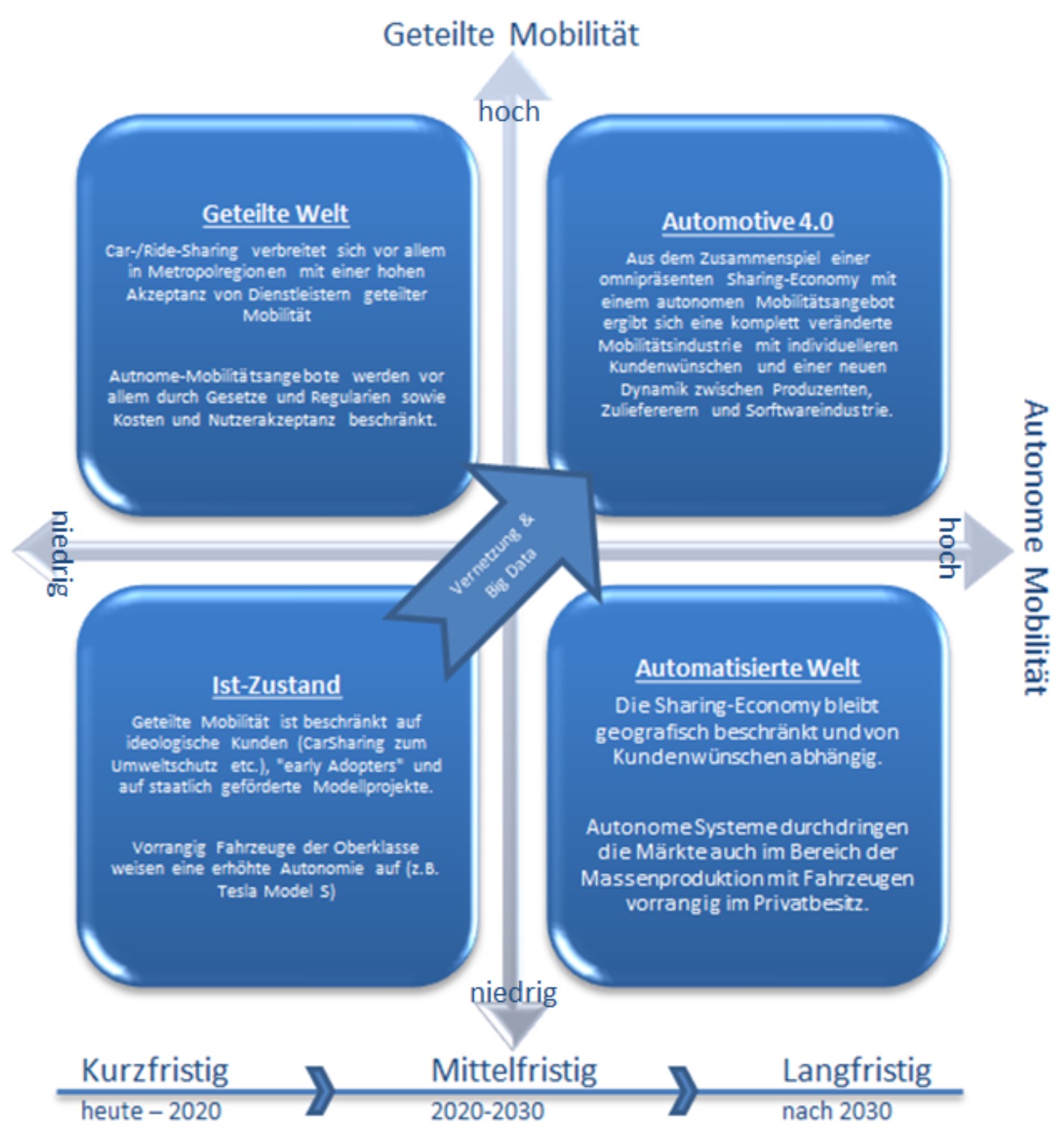Automotive 4.0 or the future of mobility
Digitisation, new technologies such as e-mobility, autonomous and connected vehicles, changing mobility needs (car-sharing, ride-sharing, etc.) and new market participants such as Google or Apple are providing far-reaching impulses that will undoubtedly change the entire “automotive industry”. This process is also described as “Automotive 4.0”.
If there are room for different development possibilities, then four scenarios are conceivable, for example. In the medium term, for example, the trend could be towards a more “divided world” or more “automated world” (see figure).
In order to better prepare for any future as a mobility provider, it is helpful to consider the underlying influences of the development:
1. Most urban centres and metropolitan areas suffer in unison from high levels of pollution and traffic. In response, environmental standards for vehicles are constantly being raised. Measures are also being taken to reduce the number of vehicles
2. So-called mobility-on-demand (MOD) offers are more accepted due to the ever-increasing degree of networking of so-called “smart devices” (smartphones, tablets, etc.), as they promise cost savings with ever better “usability”.
3. In the end, points 1 and 2 will force you to sell fewer vehicles.
4. This, in turn, will lead to smaller fleets, lower demand for used vehicles and thus lower used vehicle prices.
5. This will increase the cost of owning a vehicle in the long term, which in turn will increase the demand for shared mobility services. This is where providers of tailor-made and customizable mobility offerings will be applied.
6. A contrary impulse could be set by fully autonomous vehicles, which on the one hand could help to drastically reduce the absolute number of all required vehicles. On the other hand, there are advantages for OEM manufacturers that could become providers of full-autonomous flow-car-sharing offerings.
7. In addition, this could promote one’s own brand and create opportunities in new customer segments.
There are very different forecasts for the different scenarios. For example, for the US alone, it is predicted that the potential of Automotive 4.0 would be 32 million additional customers. This is attributed to the fact that MOD is attractive to current vehicle owners, public transport and even some users of rail and aircraft. In addition, with teenagers, older and health-handicapped people, completely new target groups are opening up, who are not yet able to actively participate in traffic themselves.
Interestingly, the above mentioned development assumes that although the total number of vehicles sold will decrease, annual vehicle sales will actually increase in order to meet the increased demand for mobility services.
Analysts predict that premium OEM manufacturers with a strong technological position in particular will benefit from the development, as the technologically poorly positioned producers in particular will hardly be able to meet the mobility services in demand in the future. However, suppliers for the mass market in particular will be disproportionately affected by the new developments caused by Automotive 4.0, as demand will change the most.
In order to meet the challenges, it is therefore necessary for all market participants:
A. Early to develop autonomous vehicles and, if necessary, to develop autonomous vehicles. enter into strategic partnerships with technology companies that have the right know-how in areas where you are not well positioned.
B. Alternatively, enter the MOD market directly, e.B. through acquisitions or the creation of innovative start-ups.
C. Focus on market segments that have as little impact on the previous business as possible.
Conclusion
The industry will change a lot. It is already a matter of aligning in time so that you can get a part of the cake and cover the new mobility requirements. In any case, the winners of the development will be the companies that are able to take advantage of digitalisation and thereby not only recognize new business models, but also adapt, change and, where necessary, completely abandon their own business models.






0 Comments